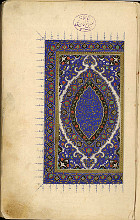Introduction
Last update: 11 January 2017

Preliminary page - Decoration
Ms. Iran, Tehran, Kitābḫānah-i Maǧlis-i Shūrā-yi Millī (now: Kitābḫānah-i Maǧlis-i Shūrā-yi Islāmī = Parliament Library), 135
The manuscript tradition of Avicenna’s Ilāhiyyāt is immense, and many manuscripts preserving the Ilāhiyyāt encompass other parts of the Šifāʾ as well, or the work in its entirety. In these varying formats, the Ilāhiyyāt is transmitted by more than two hundred and sixty manuscripts worldwide, contained either in public libraries or private collections. The fate of some of the attested manuscripts is regrettably uncertain, due to the change of location and the dispersion of holdings suffred by some depositories, especially the private collections, and the current political situation in the Middle East and Central Asia. Some of the extant manuscripts are preserved in Europe and United States (Austin; Berlin; Cambridge; Dublin; Düsseldorf; Leiden; Los Angeles; London; Madrid; Manchester; Oxford; Paris; Princeton). The majority is spread in the Near East and Central Asia: Morocco (Rabat), Tunisia (Tunis), Egypt (Cairo), Turkey (Ankara; Istanbul; İzmir; Kütahya; Manisa; Tire), Syria (Damascus), Lebanon (Beirut), Iraq (Mosul, Najaf), Afghanistan (Herat), Azerbaijan (Baku), Tajikistan (Dushanbe), Uzbekistan (Tashkent), Pakistan (Peshawar), and India (Aligarh; Hyderabad; Kolkata; Lucknow; Mubarakpour; Patna; Rampur; Varanasi). The largest repository of manuscripts is Iran, both in terms of manuscripts produced and of cities and libraries involved (Arak; Golpayegan; Hamadan; Isfahan; Kashan; Kermanshah; Khoy; Mashhad; Qazwin; Qum; Rasht; Shiraz; Tabriz; Tehran; Yazd; Zanjan), followed by Turkey and India. Iran is also the place where most manuscripts of the Ilāhiyyāt stored in private collections concentrate, thus attesting a living interest in the text of the work by Iranian scholars in the recent past until nowadays. In front of this vast scenario, the five (occasionally six) manuscripts of the Ilāhiyyāt – from Cairo and London public libraries, the oldest of which dates back to the VII/XIII c. – that serve as basis for the Cairo standard edition of the work reveal the inadequacy of this latter and the need of a more comprehensive codicological investigation.
The Ilāhiyyāt and the other parts of the Šifāʾ were copied uninterruptedly since the V/XI century, a few decades after Avicenna's death, until the XIV/XX century, less than one hundred years ago. The most ancient extant dated manuscript of the Ilāhiyyāt (Najaf, Maktabat al-Imām Amīr al-Muʾminīn, 3070) goes back to 496H/1102-3, whereas the most recent one (Qum, ʿAllāma Sayyid Muḥammad Ḥusayn Ṭabāṭabāʾī Collection, no number) dates to 1345H/1927. The gap between Avicenna’s death (428H/1037) and the first attestations of copies of the Ilāhiyyāt can be further reduced, if we rely on derivative information: on the one hand, very ancient exemplars, now apparently lost, have left their traces in extant manuscripts (the manuscript Kolkata, Asiatic Society of Bengal Library, Ar. 102, for example, attests an exemplar of 469H/1076-7); on the other hand, possession notes in extant manuscripts inform us of very early ownerships (the manuscript Tehran, Kitābḫānah-i Markazī-yi Dānišgāh-i Tihrān, 5231, for instance, reports – in all likelihood from its exemplar – an ownership note of 445H/1053). If we trust this kind of inferential information, the temporal distance between the author’s death and the first attested copies of the work does not exceed the two decades.
In this way, the manuscript tradition regarding the Ilāhiyyāt is both wider and older than the corresponding tradition regarding the Kitāb al-Išārāt wa-l-tanbīhāt: at the present stage of research, the latter work results to be preserved in about one hundred manuscripts worldwide, and its most ancient extant and dated manuscript presently known (Tehran, Kitābḫānah-i Millī Malik, 713) dates to 516H/1122 (the state-of-the-art on the manuscripts of the Kitāb al-Išārāt wa-l-tanbīhāt is provided by J. Lameer, “Towards a New Edition of Avicenna’s Kitāb al-Ishārāt wa-l-tanbīhāt”, Journal of Islamic Manuscripts, 4, 2013, pp. 199-248).
The available manuscripts of the Ilāhiyyāt provide precious information not only on the date of copying, but also on copyists, owners, and places of copying of manuscripts. Whereas most copyists are, at the present stage of research, still opaque figures, some of them appear to have been philosophers of some significance: a case in point is the Amīr al-Dīn Māniyūl, copyist of the manuscript Istanbul, Ayasofya 2442 (671-4H/1273-6), who can now be included among the commentators of Avicenna's Kitāb al-Išārāt wa-l-tanbīhāt, and who commented also on a logical work (Bayān al-Ḥaqq) of Sirāǧ al-Dīn al-Urmawī (d. 682H/1283), which is almost eclipsed by his more famous Maṭāliʿ al-Anwār: the relative chronology of this work (ante 671-4H/1273-6) can now be more precisely grasped, as well as the existence of exegetical activity upon it, attesting its circulation and prestige.
Owners of manuscripts, on the other hand, include key-figures of Arabic philosophy like Naṣīr al-Dīn al-Ṭūsī (d. 673H/1274), Ṣadr al-Dīn al-Daštakī (d. 903H/1498) and his descendants, and Mīr Dāmād (950-1041H/1542-1631), as well as enlightened rulers who played a pivotal function in the promotion and dissemination of culture in their lands (see the Mughal ruler Aqbar, reg. 1556-1605AD, to whose court in India a student of Ġiyāṯ al-Dīn Manṣūr Daštakī Šīrāzī, Fatḥ Allāh al-Šīrāzī, d. 997H/1589, presumbaly brought the ms. Rampur Raza Library, 3476 ع [ḥikma 112] of 718H/1318-9).
Places of production of manuscripts concentrate in Turkey, Iraq, Iran, and India. Occasionally, besides the name of the city where the copy was made, colophons mention also individual madrasas, in whose description the name of the founder, or of the head, of the school is often included; in this way, inspection of manuscripts increments substantially our knowledge of the social and institutional context of the transmission of learning and of the production of texts in the interested cities.
In this way, the manuscripts taken into account contribute to shed light on still shadowy figures of Arabic philosophy, to corroborate the importance of others, and to determine more precisely the concrete ways in which philosophical knowledge was transmitted in prime or minor cultural centers.
The information on copyists, owners, and place of copying provided by manuscripts is complemented by the data conveyed by historical sources: relevant exponents of falsafa of the VI/XII c. are reported to have copied the Ilāhiyyāt, either for remunerative purposes or for personal use (Zayn al-Dīn ʿUmar b. Sahlān al-Sāwī possibly before 523H/1129; ʿAbd al-Laṭīf Ibn Yūsuf al-Baġdādī before 585H/1190 in Baghdad); likewise, significant rulers have owned the Ilāhiyyāt in their private libraries (Nādir Šāh Afšār, d. 1160H/1747, the famous founder of the Afšārid dynasty in Iran after the Safavids). Their example attests the wide appeal of the work in the culture of the time and its long-lasting circulation in top-level intellectual and political circles.
The provisional lists of manuscripts available in the following sections are an updated and enlarged version of the data first gathered in A. Bertolacci, “On the Manuscripts of the Ilāhiyyāt of Avicenna’s Kitāb al-Šifāʾ ”, in Islamic Thought in the Middle Ages. Studies in Text, Transmission and Translation, in Honour of Hans Daiber, ed. A. Akasoy, W. Raven, Brill, Leiden 2008, pp. 59-75.
Philosophy on the Border of Civilizations and Intellectual Endeavours:
Towards a Critical Edition of the Metaphysics (Ilâhiyyât of Kitâb al-Šifâʾ) of Avicenna (Ibn Sînâ)
ERC Advanced Grant 339621
Scuola Normale Superiore, Pisa, Italy
Piazza dei Cavalieri, n. 7
IMT School for Advanced Studies, Lucca, Italy
Piazza S. Ponziano, n. 6
Mail: info@avicennaproject.eu



